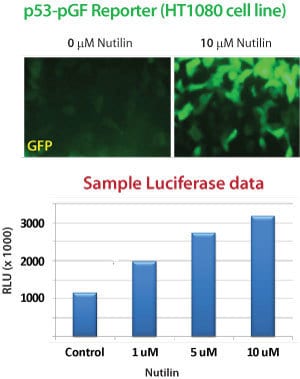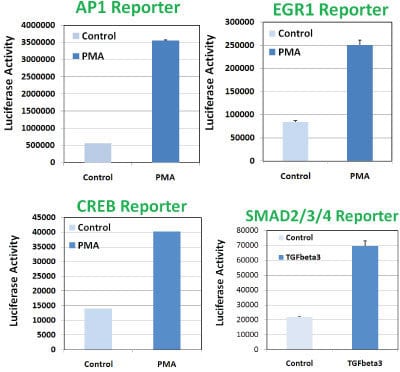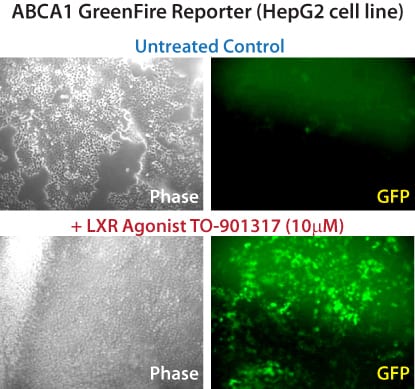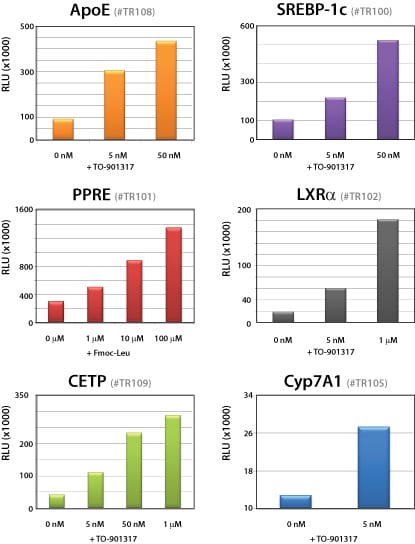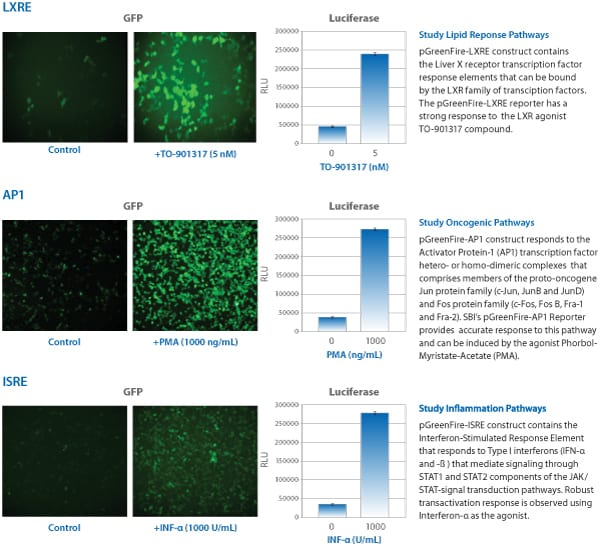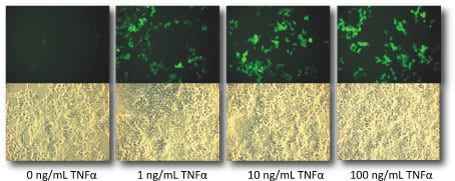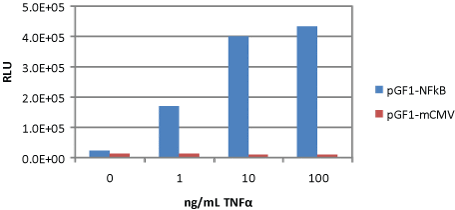pGreenFire1-STAT1 (EF1α-puro) Lentivector
- Sort responsive cells with dscGFP
- Measure activity with luciferase
- Leverage SBI’s highly-regarded lentivectors
- Create stable signaling pathway reporter cell lines
- Introduce reporters into difficult-to-transfect cell types, including primary and non-dividing mammalian cell lines
Products
| Catalog Number | Description | Size | Price | Quantity | Add to Cart | |||
|---|---|---|---|---|---|---|---|---|
| TR015PA-P | pGreenFire1-STAT1 (plasmid)+ EF1α-Puro | 10 µg | $747 |
|
||||
| TR015VA-P | pGreenFire1-STAT (virus) + EF1α-Puro | >2 x 10^6 IFUs | $747 |
|
||||
Overview
Overview
Monitor signal transduction in real time
With SBI’s line of pGreenFire1 Pathway Reporters, you can monitor signal transduction in real time. These vectors leverage our reliable lentivector technology and save you time—our pre-built signal transduction pathway reporters come as ready-to-package lentivector plasmid and ready-to-transduce pre-packaged lentivirus*. The pGreenFire1-STAT1 (EF1α-puro) Lentivector co-expresses a destabilized copepod GFP (dscGFP; 2-hour half-life) and luciferase from STAT1 transcriptional response elements (TREs) paired with a minimal CMV promoter (mCMV). The mCMV promoter alone delivers negligible expression, but when downstream of STAT1-responsive transcriptional elements, drives expression of dscGFP and luciferase in response to STAT1 activity. The result is the ability to quantitatively measure STAT1 activity by fluorescence and luciferase activity.
- Sort responsive cells with dscGFP
- Measure activity with luciferase
- Leverage SBI’s highly-regarded lentivectors
- Create stable signaling pathway reporter cell lines
- Introduce reporters into difficult-to-transfect cell types, including primary and non-dividing mammalian cell lines

To facilitate cell line construction, the pGreenFire1-STAT1 (EF1α-puro) Lentivector comes with a constitutively-expressed puromycin marker from the EF1α promoter. Or you can choose a neomycin marker (EF1α-neo; Cat.# TR015PA-N) or no marker at all (Cat.# TR015PA-1). In addition, all forms of this vector are available as both lentivector plasmid, and pre-packaged virus.
*Please note that these vectors only function properly when transduced. Transfection keeps the constitutive RSV promoter intact, leading to nonspecific expression of the reporter genes.How It Works
Supporting Data
FAQs
Resources
Related Products
Citations
-
Gampala, S, et al. (2024) New Ref-1/APE1 targeted inhibitors demonstrating improved potency for clinical applications in multiple cancer types. Pharmacological Research. 2024;:107092. Link: Pharmacological Research
-
Liu, YN, et al. (2024) Immunosuppressive role of BDNF in therapy-induced neuroendocrine prostate cancer. Molecular oncology. 2024;. PM ID: 38381121
-
Ishino, T, et al. (2023) Somatic mutations can induce a noninflamed tumour microenvironment via their original gene functions, despite deriving neoantigens. British journal of cancer. 2023;. PM ID: 36732592
-
Pandi, K, et al. (2023) Porphyromonas gingivalis induction of TLR2 association with Vinculin enables PI3K activation and immune evasion. PLoS pathogens. 2023; 19(4):e1011284. PM ID: 37023213
-
Ramachandran, M, et al. (2023) Tailoring vascular phenotype through AAV therapy promotes anti-tumor immunity in glioma. Cancer cell. 2023;. PM ID: 37172581
-
Wen, YC, et al. (2023) CHRM4/AKT/MYCN upregulates interferon alpha-17 in the tumor microenvironment to promote neuroendocrine differentiation of prostate cancer. Cell death & disease. 2023; 14(5):304. PM ID: 37142586
-
Li, X, et al. (2023) Rosmarinic acid ameliorates autoimmune responses through suppression of intracellular nucleic acid-mediated type I interferon expression. Biochemical and Biophysical Research Communications. 2023;. Link: Biochemical and Biophysical Research Communications
-
Ibrahim, L, et al. (2023) Succinylation of a KEAP1 sensor lysine promotes NRF2 activation. bioRxiv : the preprint server for biology. 2023;. PM ID: 37215033
-
Park, CS, et al. (2023) Stromal-induced epithelial-mesenchymal transition induces targetable drug resistance in acute lymphoblastic leukemia. Cell reports. 2023; 42(7):112804. PM ID: 37453060
-
Ouyang, W, et al. (2023) Development of a New Cell-Based AP-1 Gene Reporter Potency Assay for Anti-Anthrax Toxin Therapeutics. Toxins. 2023; 15(9):528. Link: Toxins
-
Zhao, G, et al. (2023) Base editing of the mutated TERT promoter inhibits liver tumor growth. Hepatology (Baltimore, Md.). 2023;. PM ID: 38016019
-
You, S & Bollong, MJ. (2023) A high throughput screen for pharmacological inhibitors of the carbohydrate response element. Scientific data. 2023; 10(1):676. PM ID: 37794069
-
Melo, CL. (2023) LUMINALABREASTCANCER: INSIGHTS INTOCELLCYCLEREGULATIONAND ESTROGENSIGNALING. Thesis. 2023;. Link: Thesis
-
Labanieh, L, et al. (2022) Enhanced safety and efficacy of protease-regulated CAR-T cell receptors. Cell. 2022;. PM ID: 35483375
-
Teng, CT, et al. (2022) SUPPLEMENTARY MATERIAL: Development of novel cell lines for high throughput screening to detect estrogen-related receptor alpha modulators. slas-discovery.org. 2022;. Link: slas-discovery.org
-
Dane, EL, et al. (2022) STING agonist delivery by tumour-penetrating PEG-lipid nanodiscs primes robust anticancer immunity. Nature materials. 2022; 21(6):710-720. PM ID: 35606429
-
Liu, Y, et al. (2022) MCTP1 promotes SNAI1-driven neuroendocrine differentiation and epithelial-to- mesenchymal transition of prostate cancer enhancement by ZBTB46/FOXA2/HIF1A. Research Square. 2022;. Link: Research Square
-
Deng, Z, Lyu, W & Zhang, G. (2022) High-Throughput Identification of Epigenetic Compounds to Enhance Chicken Host Defense Peptide Gene Expression. Antibiotics (Basel, Switzerland). 2022; 11(7). PM ID: 35884187
-
Chang, WM, et al. (2022) The aberrant cancer metabolic gene carbohydrate sulfotransferase 11 promotes non-small cell lung cancer cell metastasis via dysregulation of ceruloplasmin and intracellular iron balance. Translational oncology. 2022; 25:101508. PM ID: 35985204
-
Chen, C, et al. (2022) ATF4-dependent fructolysis fuels growth of glioblastoma multiforme. Nature communications. 2022; 13(1):6108. PM ID: 36245009
- See More
Products
| Catalog Number | Description | Size | Price | Quantity | Add to Cart | |||
|---|---|---|---|---|---|---|---|---|
| TR015PA-P | pGreenFire1-STAT1 (plasmid)+ EF1α-Puro | 10 µg | $747 |
|
||||
| TR015VA-P | pGreenFire1-STAT (virus) + EF1α-Puro | >2 x 10^6 IFUs | $747 |
|
||||
Overview
Overview
Monitor signal transduction in real time
With SBI’s line of pGreenFire1 Pathway Reporters, you can monitor signal transduction in real time. These vectors leverage our reliable lentivector technology and save you time—our pre-built signal transduction pathway reporters come as ready-to-package lentivector plasmid and ready-to-transduce pre-packaged lentivirus*. The pGreenFire1-STAT1 (EF1α-puro) Lentivector co-expresses a destabilized copepod GFP (dscGFP; 2-hour half-life) and luciferase from STAT1 transcriptional response elements (TREs) paired with a minimal CMV promoter (mCMV). The mCMV promoter alone delivers negligible expression, but when downstream of STAT1-responsive transcriptional elements, drives expression of dscGFP and luciferase in response to STAT1 activity. The result is the ability to quantitatively measure STAT1 activity by fluorescence and luciferase activity.
- Sort responsive cells with dscGFP
- Measure activity with luciferase
- Leverage SBI’s highly-regarded lentivectors
- Create stable signaling pathway reporter cell lines
- Introduce reporters into difficult-to-transfect cell types, including primary and non-dividing mammalian cell lines

To facilitate cell line construction, the pGreenFire1-STAT1 (EF1α-puro) Lentivector comes with a constitutively-expressed puromycin marker from the EF1α promoter. Or you can choose a neomycin marker (EF1α-neo; Cat.# TR015PA-N) or no marker at all (Cat.# TR015PA-1). In addition, all forms of this vector are available as both lentivector plasmid, and pre-packaged virus.
*Please note that these vectors only function properly when transduced. Transfection keeps the constitutive RSV promoter intact, leading to nonspecific expression of the reporter genes.How It Works
FAQs
Citations
-
Gampala, S, et al. (2024) New Ref-1/APE1 targeted inhibitors demonstrating improved potency for clinical applications in multiple cancer types. Pharmacological Research. 2024;:107092. Link: Pharmacological Research
-
Liu, YN, et al. (2024) Immunosuppressive role of BDNF in therapy-induced neuroendocrine prostate cancer. Molecular oncology. 2024;. PM ID: 38381121
-
Ishino, T, et al. (2023) Somatic mutations can induce a noninflamed tumour microenvironment via their original gene functions, despite deriving neoantigens. British journal of cancer. 2023;. PM ID: 36732592
-
Pandi, K, et al. (2023) Porphyromonas gingivalis induction of TLR2 association with Vinculin enables PI3K activation and immune evasion. PLoS pathogens. 2023; 19(4):e1011284. PM ID: 37023213
-
Ramachandran, M, et al. (2023) Tailoring vascular phenotype through AAV therapy promotes anti-tumor immunity in glioma. Cancer cell. 2023;. PM ID: 37172581
-
Wen, YC, et al. (2023) CHRM4/AKT/MYCN upregulates interferon alpha-17 in the tumor microenvironment to promote neuroendocrine differentiation of prostate cancer. Cell death & disease. 2023; 14(5):304. PM ID: 37142586
-
Li, X, et al. (2023) Rosmarinic acid ameliorates autoimmune responses through suppression of intracellular nucleic acid-mediated type I interferon expression. Biochemical and Biophysical Research Communications. 2023;. Link: Biochemical and Biophysical Research Communications
-
Ibrahim, L, et al. (2023) Succinylation of a KEAP1 sensor lysine promotes NRF2 activation. bioRxiv : the preprint server for biology. 2023;. PM ID: 37215033
-
Park, CS, et al. (2023) Stromal-induced epithelial-mesenchymal transition induces targetable drug resistance in acute lymphoblastic leukemia. Cell reports. 2023; 42(7):112804. PM ID: 37453060
-
Ouyang, W, et al. (2023) Development of a New Cell-Based AP-1 Gene Reporter Potency Assay for Anti-Anthrax Toxin Therapeutics. Toxins. 2023; 15(9):528. Link: Toxins
-
Zhao, G, et al. (2023) Base editing of the mutated TERT promoter inhibits liver tumor growth. Hepatology (Baltimore, Md.). 2023;. PM ID: 38016019
-
You, S & Bollong, MJ. (2023) A high throughput screen for pharmacological inhibitors of the carbohydrate response element. Scientific data. 2023; 10(1):676. PM ID: 37794069
-
Melo, CL. (2023) LUMINALABREASTCANCER: INSIGHTS INTOCELLCYCLEREGULATIONAND ESTROGENSIGNALING. Thesis. 2023;. Link: Thesis
-
Labanieh, L, et al. (2022) Enhanced safety and efficacy of protease-regulated CAR-T cell receptors. Cell. 2022;. PM ID: 35483375
-
Teng, CT, et al. (2022) SUPPLEMENTARY MATERIAL: Development of novel cell lines for high throughput screening to detect estrogen-related receptor alpha modulators. slas-discovery.org. 2022;. Link: slas-discovery.org
-
Dane, EL, et al. (2022) STING agonist delivery by tumour-penetrating PEG-lipid nanodiscs primes robust anticancer immunity. Nature materials. 2022; 21(6):710-720. PM ID: 35606429
-
Liu, Y, et al. (2022) MCTP1 promotes SNAI1-driven neuroendocrine differentiation and epithelial-to- mesenchymal transition of prostate cancer enhancement by ZBTB46/FOXA2/HIF1A. Research Square. 2022;. Link: Research Square
-
Deng, Z, Lyu, W & Zhang, G. (2022) High-Throughput Identification of Epigenetic Compounds to Enhance Chicken Host Defense Peptide Gene Expression. Antibiotics (Basel, Switzerland). 2022; 11(7). PM ID: 35884187
-
Chang, WM, et al. (2022) The aberrant cancer metabolic gene carbohydrate sulfotransferase 11 promotes non-small cell lung cancer cell metastasis via dysregulation of ceruloplasmin and intracellular iron balance. Translational oncology. 2022; 25:101508. PM ID: 35985204
-
Chen, C, et al. (2022) ATF4-dependent fructolysis fuels growth of glioblastoma multiforme. Nature communications. 2022; 13(1):6108. PM ID: 36245009
- See More


